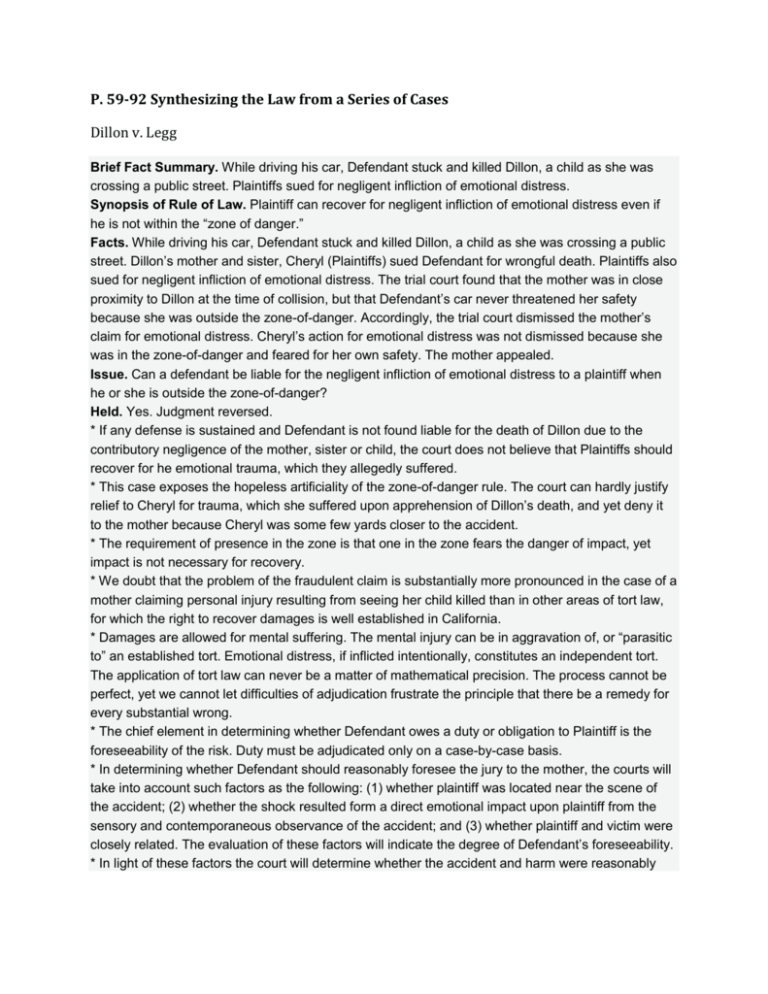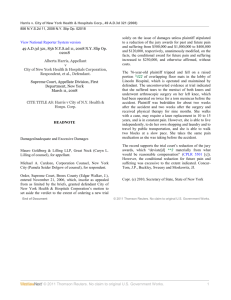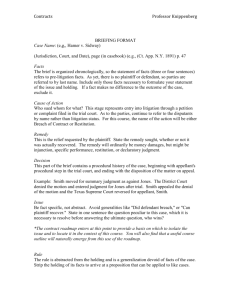Homework July 15
advertisement

P. 59-92 Synthesizing the Law from a Series of Cases Dillon v. Legg Brief Fact Summary. While driving his car, Defendant stuck and killed Dillon, a child as she was crossing a public street. Plaintiffs sued for negligent infliction of emotional distress. Synopsis of Rule of Law. Plaintiff can recover for negligent infliction of emotional distress even if he is not within the “zone of danger.” Facts. While driving his car, Defendant stuck and killed Dillon, a child as she was crossing a public street. Dillon’s mother and sister, Cheryl (Plaintiffs) sued Defendant for wrongful death. Plaintiffs also sued for negligent infliction of emotional distress. The trial court found that the mother was in close proximity to Dillon at the time of collision, but that Defendant’s car never threatened her safety because she was outside the zone-of-danger. Accordingly, the trial court dismissed the mother’s claim for emotional distress. Cheryl’s action for emotional distress was not dismissed because she was in the zone-of-danger and feared for her own safety. The mother appealed. Issue. Can a defendant be liable for the negligent infliction of emotional distress to a plaintiff when he or she is outside the zone-of-danger? Held. Yes. Judgment reversed. * If any defense is sustained and Defendant is not found liable for the death of Dillon due to the contributory negligence of the mother, sister or child, the court does not believe that Plaintiffs should recover for he emotional trauma, which they allegedly suffered. * This case exposes the hopeless artificiality of the zone-of-danger rule. The court can hardly justify relief to Cheryl for trauma, which she suffered upon apprehension of Dillon’s death, and yet deny it to the mother because Cheryl was some few yards closer to the accident. * The requirement of presence in the zone is that one in the zone fears the danger of impact, yet impact is not necessary for recovery. * We doubt that the problem of the fraudulent claim is substantially more pronounced in the case of a mother claiming personal injury resulting from seeing her child killed than in other areas of tort law, for which the right to recover damages is well established in California. * Damages are allowed for mental suffering. The mental injury can be in aggravation of, or “parasitic to” an established tort. Emotional distress, if inflicted intentionally, constitutes an independent tort. The application of tort law can never be a matter of mathematical precision. The process cannot be perfect, yet we cannot let difficulties of adjudication frustrate the principle that there be a remedy for every substantial wrong. * The chief element in determining whether Defendant owes a duty or obligation to Plaintiff is the foreseeability of the risk. Duty must be adjudicated only on a case-by-case basis. * In determining whether Defendant should reasonably foresee the jury to the mother, the courts will take into account such factors as the following: (1) whether plaintiff was located near the scene of the accident; (2) whether the shock resulted form a direct emotional impact upon plaintiff from the sensory and contemporaneous observance of the accident; and (3) whether plaintiff and victim were closely related. The evaluation of these factors will indicate the degree of Defendant’s foreseeability. * In light of these factors the court will determine whether the accident and harm were reasonably foreseeable. In this case, the presence of the above factors indicates that the mother has alleged a prima facie case. Dissent. There are two dissenting opinions in the casebook * (Chief Justice Traynor) The court’s decision in Amaya v. Home Ice, Fuel & Supply Co., was correctly decided and should not be overruled. * (Justice Burke) There are too many unanswered questions. Our trial courts will not easily escape the burden of distinguishing between litigants on the basis of the artificial and unpredictable distinctions laid out by the majority. Discussion. It is no longer required that Plaintiff be in the zone-of-danger in order to maintain an action for the negligent infliction of emotional dist Krouse v. Graham Procedural Posture 1. Who is appealing on what issues? 2. What happened in the lower court? Legal Issue 1. The question before us is whether.. Facts 1. In tort cases, the judge recites the facts of the case. Issues 1. What is the issue at hand? Holding 1. Identifying the holding may merely consist of finding the words "We hold that..." 2. The holding should include the disposition of the case. Is the ruling of the lower court affirmed? Overturned? Remanded for retrial? Rationale 1. This is how and why the court fits the particular facts and circumstances of this case into the rule. Thing v. La Chusa Brief Fact Summary. The Plaintiff, Maria Thing’s (Plaintiff) son was struck by an automobile and injured. Plaintiff did not witness the accident, but arrived at the scene shortly thereafter. Plaintiff sued the Defendant, James La Chusa (Defendant), for negligent infliction of emotional distress. Synopsis of Rule of Law. The California Supreme Court has ruled that a plaintiff must be present when an injury occurs and be closely related to the injured party to recover damages for a claim of negligent infliction of emotional distress. Facts. On December 8, 1980, John Thing, a minor, was struck by an automobile operated by the Defendant. The Plaintiff, John Thing’s mother was nearby, but neither saw nor heard the accident. Plaintiff’s daughter informed her of the injury to her son. Plaintiff rushed to the scene, where she found her son bloody and unconscious. Plaintiff sued the Defendant, alleging she suffered great emotional disturbance, shock and injury to her nervous system as a result of the emotional stress she suffered. Plaintiff also alleged that these injuries were proximately caused by the Defendant’s negligence. The court granted Defendant’s motion for summary judgment ruling as a matter of law that Plaintiff could not establish a claim for negligent infliction of emotional distress because she did not contemporaneously and sensorily perceive the accident. The Court of Appeals overruled the trial court’s grant of summary judgment. Issue. Did the Court of Appeal correctly hold that a mother who did not witness a car accident in which her son was injured could recover damages for the emotional distress she suffered when she arrived at the accident scene? Held. No. The Judgment of the Court of Appeal is reversed. * Originally in California, the right to recovery for emotional distress was allowed only if the victim himself was injured or if the plaintiff was in the “zone of danger” of the accident. This was overruled in Dillon, [Dillon v. Legg, 68 Cal.2d 728, 69 Cal.Rptr. 72, 441 F.2d 912 (1968)] when the court established a test based on whether the defendant should have reasonably foreseen the injury to plaintiff. This test takes into account whether the plaintiff was located near the scene of the accident, if the shock resulted from a direct emotional impact upon the plaintiff from the sensory observance of the accident and if the plaintiff and victim were closely related. * Future cases went on to distinguish between direct victim cases and bystander cases, with direct victims being individuals whose emotional distress is reasonably foreseeable as a consequence of the conduct of the defendant. The courts have had difficulty applying the Dillon and direct victim standards, however. * This court concludes that a clear-cut rule would be more effective in this area. Therefore a plaintiff may recover damages for emotional distress caused by observing the negligently inflicted injury of a third person only if: (1) the plaintiff is closely related to the victim; (2) the plaintiff is present at the scene at the time the injury occurs and is then aware of the injury being caused to the victim; (3) as a result suffers serious emotional distress beyond which would be expected of a disinterested witness. In the present case, Plaintiff was not present at the scene of the accident, therefore, she cannot establish a right to recover for her emotional distress. Concurrence. Chief Justice Lucas and Justices Panelli and Arguelles concur. Justice Kaufman concurred, but thought that Dillon should be overruled and liability confined to those in the zone of danger and put in fear of their own safety. Discussion. A similar cause of action, intentional infliction of emotional distress, is punitive in nature rather than negligent infliction of emotional distress, which is compensatory. Fife v. Astenius Wilks v. Hom Brief Fact Summary. White firefighters, nonparties to a consent decree, challenged a decree, which mandated affirmative action in the hiring and promotion of blacks as firefighters. Synopsis of Rule of Law. A court mandated consent decree does not preclude a subsequent suit brought on the same issue by parties not present in the earlier action. Facts. The Petitioners, the City of Alabama and the Jefferson County Personnel Board (Petitioners), had entered into a consent judgment with black firefighters setting goals for hiring blacks and promoting them. Subsequently, the Respondents, white firefighters (Respondents), nonparties to the aforementioned consent judgment, brought a reverse discrimination lawsuit against the Petitioners. The Petitioners responded that the consent decrees in the earlier suits brought by blacks mandated the procedures followed and precluded the current suit. The District Court held that the earlier consent decrees were a defense to the white firefighters’ suits, but the Court of Appeals reversed holding that because the white firefighters were not parties to the earlier litigation, their claims could not be precluded. Issue. Whether a consent decree, which mandated affirmative action could preclude another suit challenging the validity of the subject matter brought by persons not party to the prior action. Held. No. It is a principle of general application in Anglo-American jurisprudence that one is not bound by a judgment in personam in which he was not a party. This rule is part of our deep-seated tradition that everyone be afforded his day in court. Dissent. Supreme Court Justices John Paul Stevens (J. Stevens), William Brennan (J. Brennan), Thurgood Marshall (J. Marshall) and Harry Blackmun (J. Blackmun) dissented. They argued that the Petitioners made a substantial step toward eradicating a long history of pervasive racial discrimination that had plagued its fire department. The District Court, after conducting a trial and carefully considering the Respondents’ arguments, concluded that this effort is lawful and should go forward. Because Respondents have thus already had their day in court and have failed to carry their burden, they would vacate the judgment of the Court of Appeals and remand. Discussion. The Petitioners argued that because Respondents failed to intervene in the initial proceedings, their present challenge to the consent decrees constituted a collateral attack. The Supreme Court of the United States (Supreme Court) opined that a party seeking judgment binding on another could not obligate that person to intervene, rather that party needed to be joined as dictated by the Federal Rule of Civil Procedure (FRCP) 19. It accordingly calls for mandatory joinder in circumstances where a judgment rendered in the absence of a person may leave those persons who are already parties, subject to a substantial risk of incurring inconsistent obligations. Bird v. Saenz Lawrence Field Memo P. 147-162 Getting Organized Why Organize How to Organize Context Presenting the substance Writing the Conclusion Organizing an Expository Document: An Example Identifying and Presenting Issues Presenting the Rule Application: Analyzing Facts and Law Anticipating Counterarguments Providing a Conclusion Organizing a Complex Legal Document The Importance of Headings P. 202-204 Questions 1-4 1. Recent developments in Wisconsin law have made some progress in clearing up the problems encountered in the construction of the drunk while driving statute and will aid the resolution of our client’s problem. 2. In Marsh v. Alabama, 360 U.S. 501 (1946), it was found that the town was not unlike others in its accessibility and functions to the public. 3. In this determination, state membership or representation on policymaking bodies and state powers over institutional decision making would be important factors for examination. 4. To examine more closely the objectionable methods of data gathering, reflect upon the attainment of private mental records from a state entity. P. 251-271 Writing an Interoffice Memorandum What is a Memorandum? Structure of a memo Explanation of the Parts of a Memo Headings Background and Purpose Statement of the Issues Short Answer Statement of the Facts Applicable Statutes Discussion Conclusion Typical Questions Professors Ask Who are the parties? What are the facts of the case? Which court is this? How did this case get to this court? How did the lower court rule? Who is the appellant (or respondent)? What is in dispute? What question does the court have to answer? What is the common law rule? What is the policy behind the rule? Does the court fashion a new rule of law? What is the holding of the case? If the facts were changed so that (professor suggests an additional relevant fact) would the court rule the same? How did the dissent decide this case differently?





